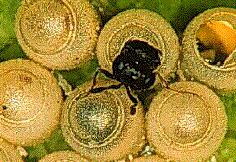Hymenopterans, the "membrane-winged" insects, include bees, ants, and a large number of other insect taxa collectively referred to as wasps. The Hymenoptera include famous examples of social insects, such as honeybees and true ants; these insects have developed regimented social systems in which members are divided into worker, drone, and queen castes. Such social hymenoptera may live together in nests or hives of many thousands of individuals, all descended form a single queen. Not all hymenoptera are social, however; many live a solitary life, coming together only for a brief mating.
As is obvious from the picture above, hymenopterans include important pollinators of flowering plants. Flowers pollinated by bees are typically yellow or blue and often have patterns visible only under ultraviolet light, which bees can see. Many bee-pollinated flowers are bilaterally symmetrical and produce abundant nectar, such as the orchids, some species of which depend on a single species of bee for pollination. Other plants may be pollinated by ants, or may rely on ants living within them to keep predators away. Many of these plants produce large quantities of nectar, or produce other fluids for the ants.
Less well-known, but equally spectacular, are the various families of parasitoid wasps; parasitoids lay eggs in living hosts, often other insects, which hatch into larvae that feed on the host's tissues before emerging. Such treatment typically kills the host; parasitoids are attracting interest as natural controls on insect pests. Other wasps parasitize the eggs or larvae of other insects, such as the wasp below, which is shown emerging from the egg of a hemipteran that was parasitized.

Hymenopterans have left behind some spectacular fossils. The best-preserved are those found in amber, which is actually fossilized sap from ancient trees. In these fossils, detail of legs, antennae, wings, and even small body hairs are preserved.
Those with an interest in the behavior of some highly evolved social hymenopterans should check out Steve's Ant Farm (11 a.m. to 5 p.m. EST; slow link), or else the Carl Hayden Honeybee Laboratory pages at the University of Arizona.
On-line newsletters for hymenopteran specialists are available from Ohio State University, where you may also find out about The International Society of Hymenopterists.


